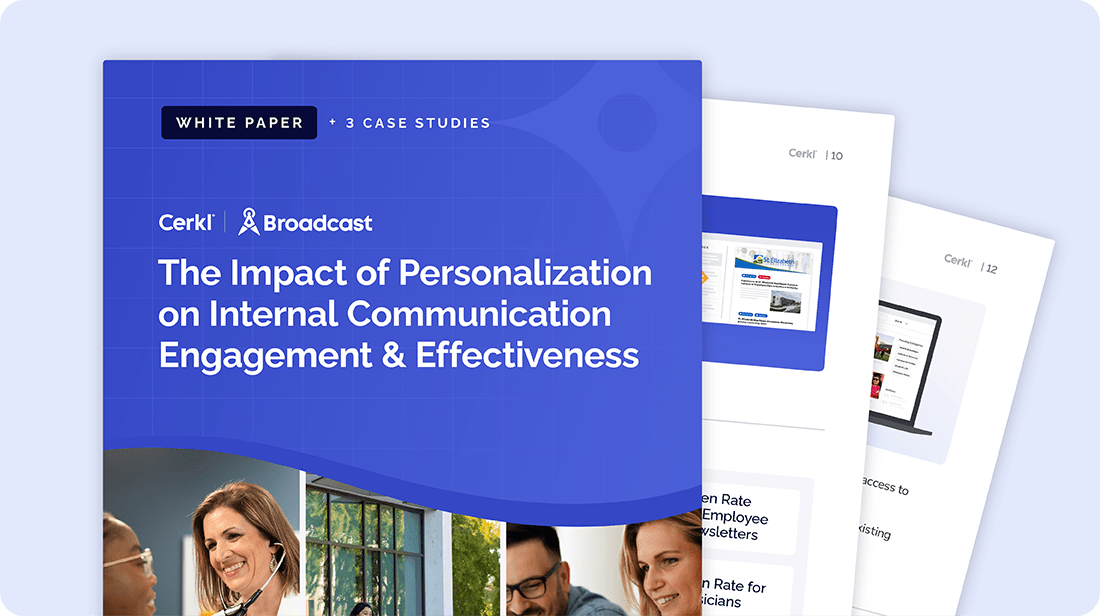 Employee Communication Best Practices
Employee Communication Best Practices
Effective internal communication is essential for aligning cultures during healthcare mergers, ensuring a smooth transition and fostering unified organizational goals.

.png)
Start communicating smarter. Download your free guide to personalization in internal communication now!
Access NowHealthcare mergers and acquisitions (M&A) are transformative, promising expanded resources, improved patient care, and greater financial stability. Yet, amid financial forecasts and strategy sessions, one critical component often determines success or failure: internal communication.
Healthcare mergers unite organizations with unique missions, cultures, and practices. When integration falters, it’s rarely because of the numbers; rather, it's the people. Internal communicators play a pivotal role in addressing these challenges, guiding employees through the uncertainty, and ensuring teams coalesce rather than clash.
"Merging two healthcare organizations brings together different cultures, which can lead to conflict or inefficiencies if not managed properly."
Rachel Mwema, Management Specialist at Ladnan Hospital
M&A is about much more than financial synergy. Healthcare employees are passionate, driven by patient care and organizational mission. Amidst merger uncertainty, employees naturally question their roles, job security, and the future of their departments. Effective internal communication acts as the organization's heartbeat, steadying fears, clarifying confusion, and unifying teams.
According to McKinsey, culture clashes cause 70-90% of mergers to fail. Healthcare organizations face amplified risks: disengagement impacts patient care, turnover drains critical talent, and fragmented cultures damage long-term outcomes. Strong internal communication mitigates these risks by fostering transparency, understanding, and a shared vision from day one.
Culture shock occurs when two distinct organizational identities merge. Consider a local hospital known for personalized patient care merging with a larger, systemized network. Employees might experience confusion over differing clinical practices, hierarchical styles, or even terminology. If left unaddressed, such issues create friction, disengagement, and eventually attrition.
Gallup’s research highlights the financial stakes, estimating that low employee engagement costs the global economy $8.8 trillion annually. Yet, engagement isn't solely financial - it's personal. Healthcare workers often choose their profession for meaningful impact; neglecting their cultural alignment undermines morale and patient outcomes.
"Employees from both sides may feel uncertain about their roles, job security, and the future of the company. This can result in decreased morale, lower productivity, and even talent attrition."
DeAnna Davis, CEO of DeAnna Davis Consulting
Boost employee engagement by implementing personalization in internal comms

Healthcare’s history includes examples of M&A failures due to poor internal communication. Consider two hospital networks whose cultures differed starkly - one employee-centric and informal, the other hierarchical and policy-driven. Without proactive, transparent communication, physicians and nurses from each side felt threatened. Misinformation spread, employees quit, and the merger struggled to deliver on its promises.
Conversely, Unison Health’s successful merger in Ontario provides a blueprint for communication done right. Leaders communicated frequently, appointing a single CEO early on as a unified voice. They conducted ongoing employee engagement surveys, adjusting their messaging based on real-time feedback. Because they addressed cultural differences openly and transparently, employees embraced the new, shared identity, preserving talent and enhancing patient outcomes.
Boost employee engagement by implementing personalization in internal comms

Here’s how healthcare communicators can proactively lead through mergers:
Communication planning starts before the deal closes. Develop a communication strategy outlining the merger's purpose, benefits, and anticipated changes. Early, clear messaging from senior leaders ensures that employees trust the vision rather than succumb to speculation.
“Early disclosure fosters a culture of transparency, which can enhance trust between management and employees. When employees feel they are being kept in the loop, they are more likely to remain engaged and committed to the company during the transition.”
Dr. Allen Nazeri, Managing Director at American Healthcare Capital
Conduct culture assessments alongside legal and financial diligence. Surveys, focus groups, and town halls help you identify potential friction points and employee concerns upfront. For instance, surveying employees early allowed Unison Health to proactively address specific fears and cultural differences.
In the thick of integration, constant communication is crucial:
Regular updates through town halls, newsletters, or an intranet also reinforce a sense of collective progress and unity.
Post-merger, internal communication solidifies the new organizational identity:
Keeping leadership visible, accessible, and engaged post-merger reassures employees and solidifies trust.
Engagement isn't just about employee satisfaction; it directly affects patient care quality and organizational performance. Gallup found that organizations with high engagement levels report higher productivity, fewer safety incidents, and better patient satisfaction. Conversely, disengaged healthcare employees risk patient outcomes and operational success.
Consistent internal communication, even simply regular email or face-to-face meetings, significantly boosts engagement by making employees feel valued and connected. Recognizing employee efforts, especially during transitional periods, can turn engaged employees into culture ambassadors who lead their peers positively through integration challenges.
Mergers inherently bring together diverse employee groups, presenting an opportunity to emphasize diversity, equity, and inclusion (DEI). Effective DEI communication builds trust and engagement by ensuring employees from both organizations feel valued and included from day one.
Recent data from Culture Amp indicates companies prioritizing DEI have significantly higher engagement (84% vs. 20%) and reduced turnover. Inclusive language, two-way communication forums, and celebrating diverse achievements foster a culture where all employees feel represented, improving retention and collaboration.
In healthcare mergers, success hinges on people, not just processes. Internal communication ensures employees remain aligned, engaged, and motivated, even amid major transitions. By addressing cultural issues proactively, leveraging DEI strategies, and prioritizing transparent dialogue, healthcare organizations can significantly boost the odds of successful integration.
Your role as an internal communicator is pivotal. To deepen your understanding and equip yourself with powerful communication strategies that drive success in M&A scenarios, download our comprehensive white paper, The Importance of Internal Communication. Packed with insights, data-backed strategies, and actionable steps, this resource is essential reading for healthcare internal communicators navigating the challenges of mergers and acquisitions.

Boost employee engagement by implementing personalization in internal comms
1. Why is internal communication critical during healthcare mergers and acquisitions (M&A)?
Effective internal communication ensures that employees are informed, engaged, and aligned with the organization's vision during M&A. It helps mitigate uncertainties, reduces misinformation, and fosters a unified culture, which is vital for successful integration and maintaining high-quality patient care.
2. What are common challenges in internal communication during healthcare M&A?
Challenges include addressing cultural differences between merging entities, managing employee anxieties about job security, ensuring consistent messaging across departments, and maintaining transparency to build trust throughout the organization.
3. How can organizations proactively address cultural differences during integration?
Organizations can conduct cultural assessments to understand the values and practices of each entity, facilitate open dialogues to discuss and reconcile differences, and develop a shared set of values and goals that reflect the unified organization's mission.
4. What strategies can enhance employee engagement during M&A transitions?
Strategies include providing regular updates through multiple communication channels, creating forums for employees to voice concerns and ask questions, recognizing and addressing employee contributions, and involving employees in decision-making processes to foster a sense of ownership.
5. Are there tools or resources to assist in managing internal communication during M&A?
Yes, organizations like Cerkl offer internal communication platforms with features like real-time updates, feedback mechanisms, and analytics to gauge engagement. Additionally, consulting with communication experts and providing training sessions can equip leaders and staff with the skills needed for effective communication during transitions.

Boost employee engagement by implementing personalization in internal comms